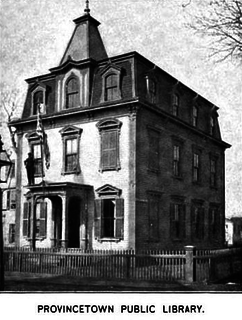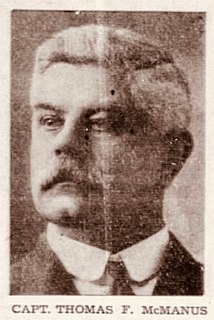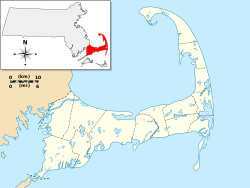
Provincetown is a New England town located at the extreme tip of Cape Cod in Barnstable County, Massachusetts, in the United States. A small coastal resort town with a year-round population of 3,664 as of the 2020 United States Census, Provincetown has a summer population as high as 60,000. Often called "P-town" or "P'town", the locale is known for its beaches, harbor, artists, tourist industry, and as a popular vacation destination for the LGBT+ community.

An art colony, also known as an artists' colony, can be defined two ways. Its most liberal description refers to the organic congregation of artists in towns, villages and rural areas, often drawn by areas of natural beauty, the prior existence of other artists or art schools there, and a lower cost of living. More commonly, the term refers to the guest-host model of a mission-driven planned community, which administers a formal process for awarding artist residencies. In the latter case, a typical mission might include providing artists with the time, space and support to create; fostering community among artists; and providing arts education to the public. Early 20th century American guest-host models include New Hampshire's MacDowell Colony and New York's Yaddo.

The Wadsworth Atheneum is an art museum in Hartford, Connecticut. The Wadsworth is noted for its collections of European Baroque art, ancient Egyptian and Classical bronzes, French and American Impressionist paintings, Hudson River School landscapes, modernist masterpieces and contemporary works, as well as collections of early American furniture and decorative arts.

The Walters Art Museum, located in Mount Vernon-Belvedere, Baltimore, Maryland, United States, is a public art museum founded and opened in 1934. It holds collections established during the mid-19th century. The Museum's collection was amassed substantially by major American art and sculpture collectors, a father and son: William Thompson Walters, (1819–1894), who began collecting when he moved to Paris as a nominal Southern/Confederate sympathizer at the outbreak of the American Civil War in 1861; and Henry Walters (1848–1931), who refined the collection and made arrangements for the construction of a later landmark building to rehouse it. After allowing the Baltimore public to occasionally view his father's and his growing added collections at his West Mount Vernon Place townhouse/mansion during the late 1800s, he arranged for an elaborate stone palazzo-styled structure built for that purpose in 1905–1909. Located across the back alley, a block south of the Walters mansion on West Monument Street/Mount Vernon Place, on the northwest corner of North Charles Street at West Centre Street.

The San Francisco Maritime National Historical Park is located in San Francisco, California, United States. The park includes a fleet of historic vessels, a visitor center, a maritime museum, and a library/research facility. The park used to be referred to as the San Francisco Maritime Museum, however the former 1951 name changed in 1978 when the collections were acquired by the National Park Service. Today's San Francisco Maritime National Historical Park was authorized in 1988; the maritime museum is among the park's many cultural resources. The park also incorporates the Aquatic Park Historic District, bounded by Van Ness Avenue, Polk Street, and Hyde Street.

The Chrysler Museum of Art is an art museum on the border between downtown and the Ghent district of Norfolk, Virginia. The museum was founded in 1933 as the Norfolk Museum of Arts and Sciences. In 1971, automotive heir, Walter P. Chrysler Jr., donated most of his extensive collection to the museum. This single gift significantly expanded the museum's collection, making it one of the major art museums in the Southeastern United States. From 1958 to 1971, the Chrysler Museum of Art was a smaller museum consisting solely of Chrysler's personal collection and housed in the historic Center Methodist Church in Provincetown, Massachusetts. Today's museum sits on a small body of water known as The Hague.

The schooner Bowdoin was designed by William H. Hand, Jr., and built in 1921, in East Boothbay, Maine, at the Hodgdon Brothers Shipyard now known as Hodgdon Yachts. She is the only American schooner built specifically for Arctic exploration, and was designed under the direction of explorer Donald B. MacMillan. She has made 29 trips above the Arctic Circle in her life, three since she was acquired by the Maine Maritime Academy in 1988. She is currently owned by the Maine Maritime Academy, located in Castine, Maine, and is used for their sail training curriculum. She is named for Bowdoin College.

The Provincetown Historic District encompasses most of the dense urban center of Provincetown, Massachusetts. The district is roughly bounded to the north by U.S. Route 6; to the west by the west end of Commercial St.; to the south by Provincetown Harbor; and to the east by the southeast end of Commercial St. It covers about 300 acres (120 ha), and includes more than 1,000 buildings. Its historic character spans more than 200 years of settlement, from the city's early years as a fishing community, to its development as a summer resort area and artists' colony beginning in the late 19th century. The district was listed in the National Register of Historic Places in 1989. Four properties in the district are also individually listed.

The Old Provincetown Public Library building is a historic building at 330 Commercial Street in downtown Provincetown, Massachusetts. Built in 1874, it served as the town's public library from then until 2002, when the library was moved to the former Center Methodist Church. The building, a fine local example of Second Empire architecture, now houses the local tourist board. It was listed on the National Register of Historic Places in 1975.

The Paul Palmer was a five-masted schooner built in 1902 by George F. Welt in Waldoboro, Maine.

Save America's Treasures is a United States federal government initiative to preserve and protect historic buildings, arts, and published works. It is a public–private partnership between the U.S. National Park Service and the National Trust for Historic Preservation. The National Endowment for the Arts, National Endowment for the Humanities, and Institute of Museum and Library Services are also partners in the work. In the early years of the program, Heritage Preservation and the National Park Foundation were also involved.
Otterville is a village in Norwich Township in Oxford County, Ontario, Canada. It is located on the Otter Creek with many historic features including Otterville Mill and Dam, Grand Trunk Station, African Methodist Episcopal Cemetery and a park.

The Peabody Museum of Salem (1915–1992), formerly the Peabody Academy of Science (1865–1915), was a museum and antiquarian society based in Salem, Massachusetts. The academy was organized in part as a successor to the East India Marine Society, which had become moribund but held a large collection of maritime materials in a museum collection at the East India Marine Hall, built in 1825 on Essex Street. The Peabody Museum was merged with the Essex Institute to form the Peabody Essex Museum in 1992. The East India Marine Hall, now embedded within the latter's modern structure, was designated a National Historic Landmark in 1965 in recognition of this heritage, which represents the nation's oldest continuously-operating museum collection.

The Provincetown Art Association and Museum (PAAM) is located at 460 Commercial Street in Provincetown, Massachusetts. It is accredited by the American Alliance of Museums and is the most attended art museum on Cape Cod. The museum's permanent collection includes over 2,500 objects, a number which continues to grow through donations and new acquisitions. PAAM mounts approximately forty exhibitions each year.

Povey Brothers Studio, also known as Povey Brothers Art Glass Works or Povey Bros. Glass Co., was an American producer of stained glass windows based in Portland, Oregon. The studio was active from 1888 to 1928. As the largest and best known art glass company in Oregon, it produced windows for homes, churches, and commercial buildings throughout the West. When the firm was founded in 1888, it was the only creative window firm in Portland, then a city of 42,000 residents.

The Racine Heritage Museum is a historical museum building and former Carnegie library, located at 701 S. Main St. in downtown Racine, Wisconsin. Designed by John Mauran in the Beaux-Arts style, the building served as the Racine Public Library from 1904 until 1958, and has housed the Racine Heritage Museum since 1963. It is also the home of the Racine County Historical Society. It was added to the National Register of Historic Places on March 20, 1981.
Walter Percy Chrysler Jr. was an American art collector, museum benefactor, and collector of other objects such as stamps, rare books, and glassworks. He was also a theatre and film producer.
Founded in 1916, the Columbia County Historical Society and CCHS Museum & Library collects, preserves, interprets, and presents the history, heritage, and culture of Columbia County, New York, and serves residents of all eighteen Columbia County towns and the city of Hudson.

Thomas Francis McManus was a fish merchant who became a naval architect, responsible for introducing the shortened bowsprit and long stern overhang to give speed to his vessels. He was well known for revolutionizing the Gloucester fishing schooner. He made the fastest vessels of their type in the world and was honored on two continents for his skill as a naval architect. He became known as the "Father of the Fishermen's Races." 500 fishing schooners used his designs to improve speed. He was a friend of Sir Thomas Lipton and President Theodore Roosevelt.





















